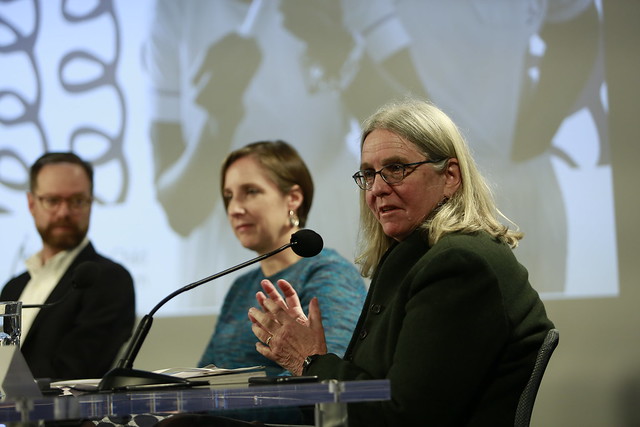-
Strengthening Health Systems Improves Healthcare for Women, Children, and Youth
March 9, 2018 By Yuval Cohen
“We cannot achieve our goals of ending maternal and child deaths without addressing critical health system barriers around the world,” said Grace Chee of the U.S. Agency for International Development (USAID)’s flagship Maternal and Child Survival Program at a recent Wilson Center event. To improve the lives of mothers and children, health workers must address the underlying causes of poor health outcomes, including systemic weaknesses in health care governance, financing, and human resources.
Health Workers: Critical Building Blocks
To deliver quality services to women and children, “all elements of the health system need to converge,” said Chee, referring to the World Health Organization’s six “Health Systems Building Blocks”: governance, financing, health workforce, medical products and technology, information, and service delivery.
“High quality and coverage of these essential services cannot be achieved without trained and motivated health workers, who have the medicines, equipment, and technology that they need to deliver these services,” said Chee, which—in turn—depends on strong leadership and greater financing.
Human resources is an essential building block in Liberia, said Dr. Birhanu Getahun: “The health workforce capacity has been built at county, district, and national levels, so they do have the soft skills to strengthen the health system.”
Similarly, in Rwanda, the Low-Dose High-Frequency mentorship program deployed traveling mentors to train providers “within their working environment,” said Dr. Stephen Mutwiwa. Since the launch of the program in 2016, the total number of providers in Rwanda trained in basic emergency obstetric and newborn care, child health, and family planning has increased three-fold.
Governance and Financing: Changing the System From Within
Like all international development programs, programs aimed at providing technical assistance to improve maternal and child health should work closely with national and local government leaders, because “only they can really change the system from within,” Chee said.

In Nigeria, the lack of centralized governance has slowed progress in reducing maternal mortality and under-five mortality rates, said Lee Pyne-Mercier of the Bill and Melinda Gates Foundation. The large number of donor and non-governmental partners in Nigeria have “led to significant fragmentation and duplication of effort,” said Pyne-Mercier. The Gates Foundation is working with national leaders to coordinate efforts and develop a single set of long-term goals for the health system.
Official development assistance (ODA), while at a record high, continues to make up only a small sliver of total development assistance worldwide, according to Dr. Mariam Claeson from the Global Financing Facility (GFF). Other sources include foreign direct investment, remittances, and domestic financing.
“How can we use, smartly, our ODA to leverage those other sources of finance for women, children, and adolescents?” said Dr. Claeson. GFF estimates that an additional $33.3 billion would be needed to cover the global need for reproductive, maternal, newborn, child, and adolescent health services—but currently total development assistance worldwide—for all needs—is roughly $36 billion.
The Global Financing Facility seeks to close the funding gap by encouraging country leaders to mobilize domestic resources, providing technical support for health finance reforms, and identifying target areas for investment. “We have to put the country…in the driver’s seat,” Dr. Claeson said.
Governments can assess their progress by asking, “Is money going to underserved areas? Are domestic resources increasing over total government resources? Are there more technical health personnel assigned to the primary healthcare level?” said Dr. Claeson. These disbursement-linked indicators, developed by the World Bank, help to bring investments to the frontline by identifying neglected areas, said Dr. Claeson.
Data: Measuring What Works
Data—collecting and assessing it—is critical to a well-functioning health system. For example, Dr. Koki Agarwal, the director of USAID’s Maternal and Child Survival Program, noted that while antenatal care is highly utilized by women worldwide, “we still don’t know what services are being provided and how effective they are,” she said.
To be useful, data must be accessible, said Mary Taylor of the Arctic University of Norway. “It is most important that everybody have the capacity to actually understand and use that data at the levels at which they work,” she said.
Kelly Saldaña, from USAID Global Health Bureau, encouraged development programs to work within already existing open-source data systems, such as the District Health Information Software 2, which is used in Rwanda by health facilities to monitor key indicators for maternal, newborn, and child health.
Dr. Agarwal urged development workers to “think differently about how we invest in our country programs and what outcomes we are interested in.” Along those lines, Saldaña urged us to remember that the Sustainable Development Goals look very different in each country context.
“Only by changing how the system fundamentally operates,” said Chee, “can we have sustainable improvement.”
Sources: Bill and Melinda Gates Foundation, District Health Information Software 2, Global Financing Facility, Jhpiego, United Nations, USAID, USAID’s flagship Maternal and Child Survival Program, World Bank, World Health Organization
Photo Credit: Lindsay Mgbor/UK Department for International Development
Subscribe:









